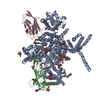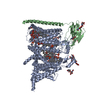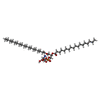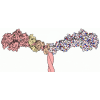+ Open data
Open data
- Basic information
Basic information
| Entry | Database: PDB / ID: 8xmm | ||||||
|---|---|---|---|---|---|---|---|
| Title | Voltage-gated sodium channel Nav1.7 variant M9 | ||||||
 Components Components | (Sodium channel ...) x 2 | ||||||
 Keywords Keywords | MEMBRANE PROTEIN / Voltage-gated sodium channel | ||||||
| Function / homology |  Function and homology information Function and homology informationcorticospinal neuron axon guidance / positive regulation of voltage-gated sodium channel activity / action potential propagation / detection of mechanical stimulus involved in sensory perception / regulation of atrial cardiac muscle cell membrane depolarization / membrane depolarization during Purkinje myocyte cell action potential / cardiac conduction / membrane depolarization during cardiac muscle cell action potential / membrane depolarization during action potential / positive regulation of sodium ion transport ...corticospinal neuron axon guidance / positive regulation of voltage-gated sodium channel activity / action potential propagation / detection of mechanical stimulus involved in sensory perception / regulation of atrial cardiac muscle cell membrane depolarization / membrane depolarization during Purkinje myocyte cell action potential / cardiac conduction / membrane depolarization during cardiac muscle cell action potential / membrane depolarization during action potential / positive regulation of sodium ion transport / regulation of sodium ion transmembrane transport / regulation of ventricular cardiac muscle cell membrane repolarization / cardiac muscle cell action potential involved in contraction / node of Ranvier / voltage-gated sodium channel complex / sodium channel inhibitor activity / locomotion / neuronal action potential propagation / Interaction between L1 and Ankyrins / voltage-gated sodium channel activity / Phase 0 - rapid depolarisation / detection of temperature stimulus involved in sensory perception of pain / regulation of heart rate by cardiac conduction / behavioral response to pain / intercalated disc / membrane depolarization / sodium channel regulator activity / neuronal action potential / cardiac muscle contraction / axon terminus / sensory perception of pain / T-tubule / sodium ion transmembrane transport / axon guidance / post-embryonic development / circadian rhythm / positive regulation of neuron projection development / response to toxic substance / Sensory perception of sweet, bitter, and umami (glutamate) taste / perikaryon / transmembrane transporter binding / cell adhesion / inflammatory response / axon / extracellular region / plasma membrane Similarity search - Function | ||||||
| Biological species |  Homo sapiens (human) Homo sapiens (human) | ||||||
| Method | ELECTRON MICROSCOPY / single particle reconstruction / cryo EM / Resolution: 2.89 Å | ||||||
 Authors Authors | Yan, N. / Li, Z. / Wu, Q. / Huang, G. | ||||||
| Funding support |  China, 1items China, 1items
| ||||||
 Citation Citation |  Journal: Proc Natl Acad Sci U S A / Year: 2024 Journal: Proc Natl Acad Sci U S A / Year: 2024Title: Dissection of the structure-function relationship of Na channels. Authors: Zhangqiang Li / Qiurong Wu / Gaoxingyu Huang / Xueqin Jin / Jiaao Li / Xiaojing Pan / Nieng Yan /  Abstract: Voltage-gated sodium channels (Na) undergo conformational shifts in response to membrane potential changes, a mechanism known as the electromechanical coupling. To delineate the structure-function ...Voltage-gated sodium channels (Na) undergo conformational shifts in response to membrane potential changes, a mechanism known as the electromechanical coupling. To delineate the structure-function relationship of human Na channels, we have performed systematic structural analysis using human Na1.7 as a prototype. Guided by the structural differences between wild-type (WT) Na1.7 and an eleven mutation-containing variant, designated Na1.7-M11, we generated three additional intermediate mutants and solved their structures at overall resolutions of 2.9-3.4 Å. The mutant with nine-point mutations in the pore domain (PD), named Na1.7-M9, has a reduced cavity volume and a sealed gate, with all voltage-sensing domains (VSDs) remaining up. Structural comparison of WT and Na1.7-M9 pinpoints two residues that may be critical to the tightening of the PD. However, the variant containing these two mutations, Na1.7-M2, or even in combination with two additional mutations in the VSDs, named Na1.7-M4, failed to tighten the PD. Our structural analysis reveals a tendency of PD contraction correlated with the right shift of the static inactivation I-V curves. We predict that the channel in the resting state should have a "tight" PD with down VSDs. | ||||||
| History |
|
- Structure visualization
Structure visualization
| Structure viewer | Molecule:  Molmil Molmil Jmol/JSmol Jmol/JSmol |
|---|
- Downloads & links
Downloads & links
- Download
Download
| PDBx/mmCIF format |  8xmm.cif.gz 8xmm.cif.gz | 291.8 KB | Display |  PDBx/mmCIF format PDBx/mmCIF format |
|---|---|---|---|---|
| PDB format |  pdb8xmm.ent.gz pdb8xmm.ent.gz | 215.7 KB | Display |  PDB format PDB format |
| PDBx/mmJSON format |  8xmm.json.gz 8xmm.json.gz | Tree view |  PDBx/mmJSON format PDBx/mmJSON format | |
| Others |  Other downloads Other downloads |
-Validation report
| Summary document |  8xmm_validation.pdf.gz 8xmm_validation.pdf.gz | 2.2 MB | Display |  wwPDB validaton report wwPDB validaton report |
|---|---|---|---|---|
| Full document |  8xmm_full_validation.pdf.gz 8xmm_full_validation.pdf.gz | 2.2 MB | Display | |
| Data in XML |  8xmm_validation.xml.gz 8xmm_validation.xml.gz | 53.6 KB | Display | |
| Data in CIF |  8xmm_validation.cif.gz 8xmm_validation.cif.gz | 77.1 KB | Display | |
| Arichive directory |  https://data.pdbj.org/pub/pdb/validation_reports/xm/8xmm https://data.pdbj.org/pub/pdb/validation_reports/xm/8xmm ftp://data.pdbj.org/pub/pdb/validation_reports/xm/8xmm ftp://data.pdbj.org/pub/pdb/validation_reports/xm/8xmm | HTTPS FTP |
-Related structure data
| Related structure data |  38482MC  8xmnC  8xmoC M: map data used to model this data C: citing same article ( |
|---|---|
| Similar structure data | Similarity search - Function & homology  F&H Search F&H Search |
- Links
Links
- Assembly
Assembly
| Deposited unit | 
|
|---|---|
| 1 |
|
- Components
Components
-Sodium channel ... , 2 types, 2 molecules AB
| #1: Protein | Mass: 231572.266 Da / Num. of mol.: 1 Source method: isolated from a genetically manipulated source Source: (gene. exp.)  Homo sapiens (human) / Gene: SCN9A, NENA / Cell line (production host): HEK293 / Production host: Homo sapiens (human) / Gene: SCN9A, NENA / Cell line (production host): HEK293 / Production host:  Homo sapiens (human) / References: UniProt: Q15858 Homo sapiens (human) / References: UniProt: Q15858 |
|---|---|
| #2: Protein | Mass: 26355.857 Da / Num. of mol.: 1 Source method: isolated from a genetically manipulated source Source: (gene. exp.)  Homo sapiens (human) / Gene: SCN1B / Cell line (production host): HEK293 / Production host: Homo sapiens (human) / Gene: SCN1B / Cell line (production host): HEK293 / Production host:  Homo sapiens (human) / References: UniProt: Q07699 Homo sapiens (human) / References: UniProt: Q07699 |
-Sugars , 2 types, 8 molecules 
| #3: Polysaccharide | Source method: isolated from a genetically manipulated source #4: Sugar | ChemComp-NAG / |
|---|
-Non-polymers , 5 types, 18 molecules 








| #5: Chemical | ChemComp-CLR / | ||||||
|---|---|---|---|---|---|---|---|
| #6: Chemical | ChemComp-LPE / #7: Chemical | ChemComp-1PW / ( | #8: Chemical | ChemComp-PCW / #9: Chemical | ChemComp-P5S / | |
-Details
| Has ligand of interest | N |
|---|---|
| Has protein modification | Y |
-Experimental details
-Experiment
| Experiment | Method: ELECTRON MICROSCOPY |
|---|---|
| EM experiment | Aggregation state: PARTICLE / 3D reconstruction method: single particle reconstruction |
- Sample preparation
Sample preparation
| Component | Name: Voltage-gated sodium channel Nav1.7-M9 / Type: COMPLEX / Entity ID: #1-#2 / Source: RECOMBINANT |
|---|---|
| Source (natural) | Organism:  Homo sapiens (human) Homo sapiens (human) |
| Source (recombinant) | Organism:  Homo sapiens (human) Homo sapiens (human) |
| Buffer solution | pH: 7.5 |
| Specimen | Embedding applied: NO / Shadowing applied: NO / Staining applied: NO / Vitrification applied: YES |
| Vitrification | Cryogen name: ETHANE |
- Electron microscopy imaging
Electron microscopy imaging
| Experimental equipment |  Model: Titan Krios / Image courtesy: FEI Company |
|---|---|
| Microscopy | Model: FEI TITAN KRIOS |
| Electron gun | Electron source:  FIELD EMISSION GUN / Accelerating voltage: 300 kV / Illumination mode: FLOOD BEAM FIELD EMISSION GUN / Accelerating voltage: 300 kV / Illumination mode: FLOOD BEAM |
| Electron lens | Mode: BRIGHT FIELD / Nominal defocus max: 1800 nm / Nominal defocus min: 1500 nm |
| Image recording | Electron dose: 50 e/Å2 / Film or detector model: GATAN K3 (6k x 4k) |
- Processing
Processing
| EM software | Name: PHENIX / Version: 1.18_3855: / Category: model refinement | ||||||||||||||||||||||||
|---|---|---|---|---|---|---|---|---|---|---|---|---|---|---|---|---|---|---|---|---|---|---|---|---|---|
| CTF correction | Type: PHASE FLIPPING AND AMPLITUDE CORRECTION | ||||||||||||||||||||||||
| 3D reconstruction | Resolution: 2.89 Å / Resolution method: FSC 0.143 CUT-OFF / Num. of particles: 483417 / Symmetry type: POINT | ||||||||||||||||||||||||
| Refine LS restraints |
|
 Movie
Movie Controller
Controller





 PDBj
PDBj
















